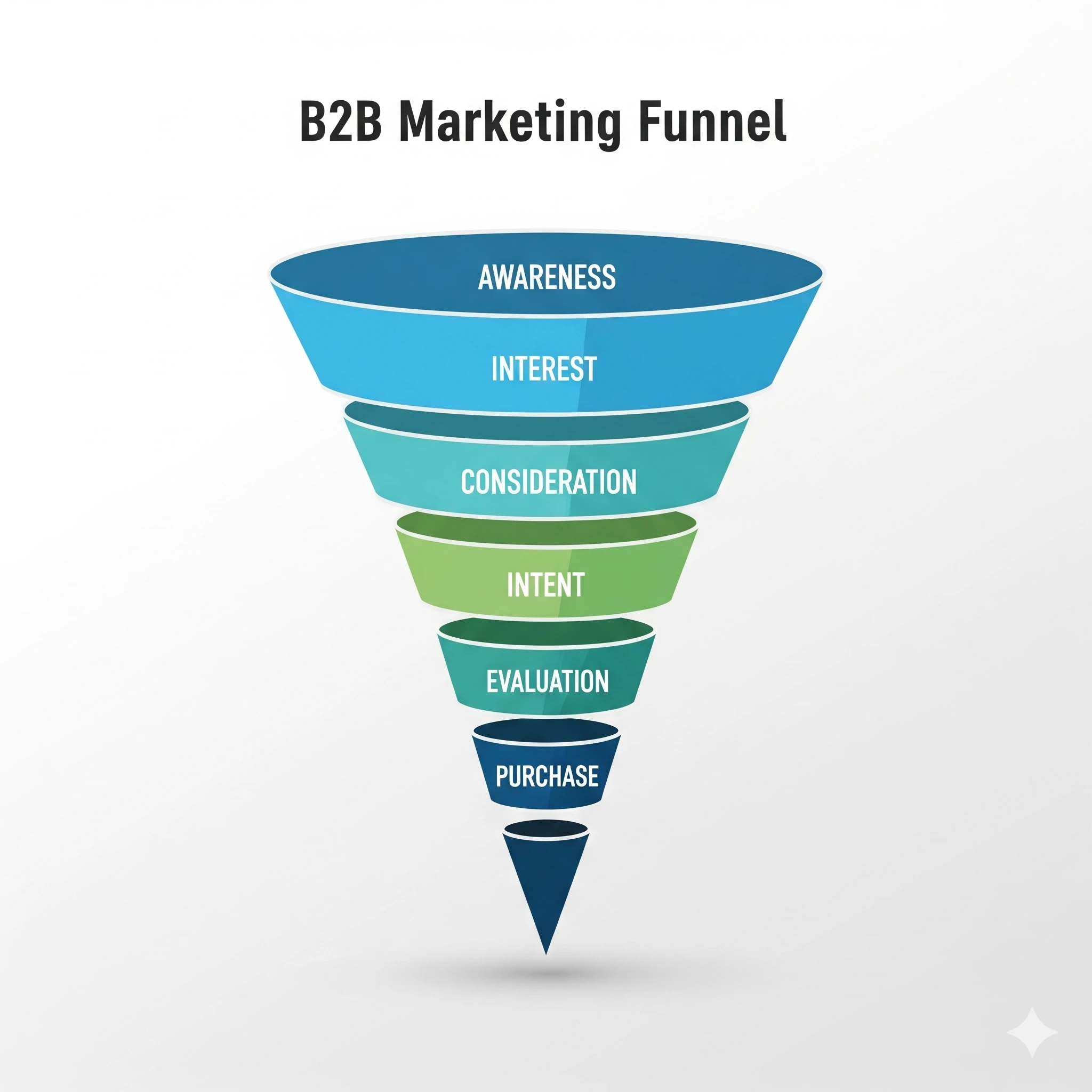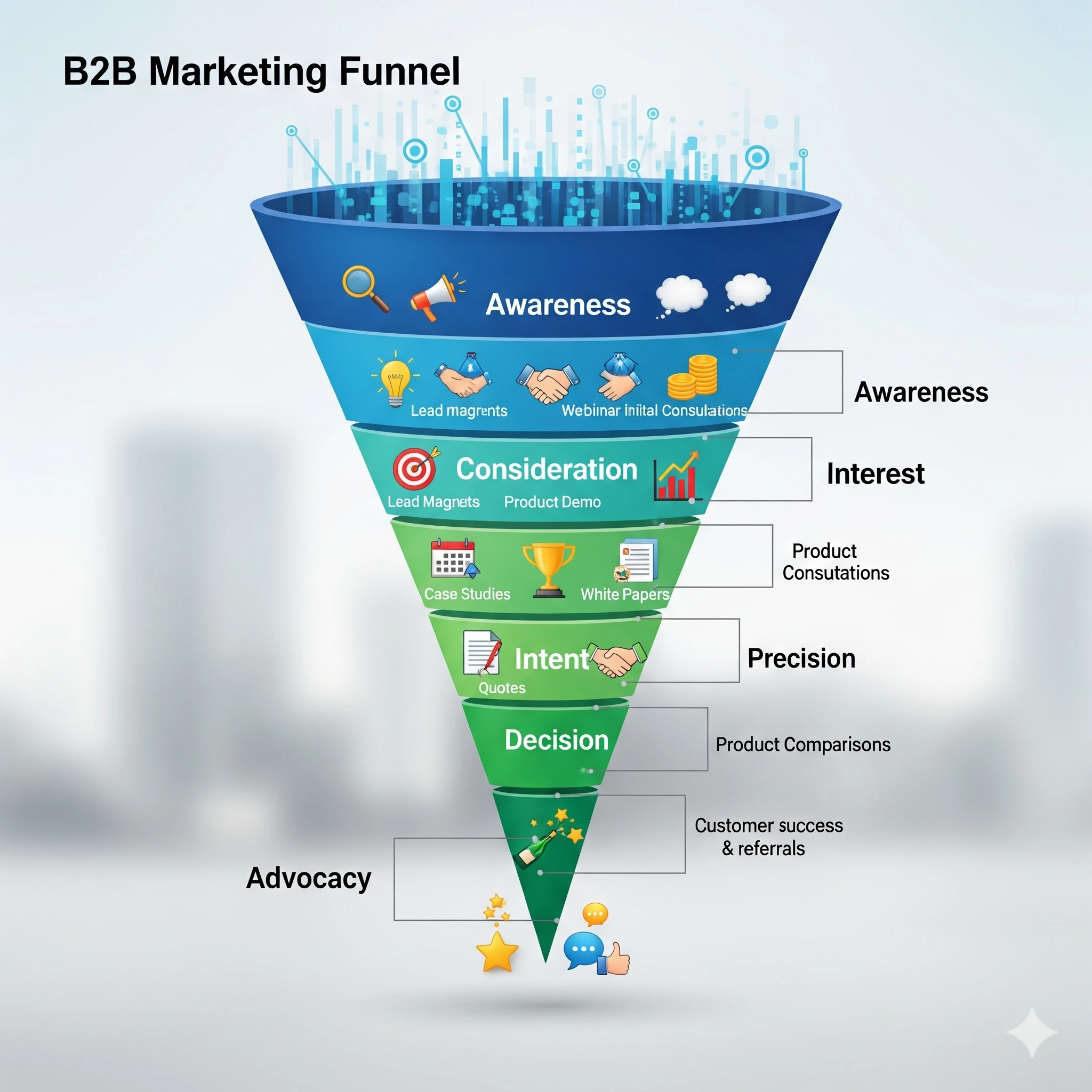
B2B Marketing Funnel Explained: Build & Optimize 2025
Summary:
Building a successful B2B Marketing Funnel in 2025 isn’t just about generating leads, it’s about guiding prospects through a clear journey that builds trust, proves value, and ultimately drives conversions. From creating awareness to turning customers into advocates, the funnel is the framework that makes growth scalable and predictable.
In this guide, we’ll break down each stage of the B2B sales funnel, show you how to build one step by step, and share practical tips to optimize it for today’s market. Whether you’re focused on demand generation, lead nurturing, or sales pipeline optimization, this article will give you the tools and strategies to thrive in 2025.

A B2B Marketing Funnel is the structured path that guides potential buyers through their journey, starting from when they first learn about your brand to the moment they become loyal advocates. Think of it as a roadmap of the customer journey in B2B, with carefully placed signboards that direct them closer to a purchase.
In simple terms: it’s how you attract, nurture, convert, and retain customers in a way that makes growth predictable.
Why does this matter in 2025? Because the modern buyer doesn’t behave like they did five years ago. According to Gartner, today’s B2B buyer consults 3–5 pieces of content before ever talking to sales. Decision-making now involves committees, not just individuals. That means a funnel isn’t a luxury, it’s survival.
For example, a SaaS startup I worked with had a brilliant product but no funnel. They relied on cold outreach and random referrals. Leads trickled in, but conversions were flat. Once they built a structured lead generation funnel, with content at the awareness stage, nurturing campaigns at consideration, and strong offers at decision, they tripled pipeline revenue within a year.
That’s the difference: a funnel isn’t just theory. It’s the backbone of predictable sales growth.

Stages of the B2B Marketing Funnel (Step-by-Step)
While every company tailors their funnel, most B2B sales funnels share four big stages. Let’s break them down with examples.
Stage 1: Awareness
This is where the relationship begins. Buyers don’t know you yet. They’re just realizing they have a problem or opportunity.
- Goal: Attract potential buyers and get on their radar.
- Best channels: SEO-driven blogs, LinkedIn posts, industry webinars, podcasts, thought-leadership reports, and sometimes even offline events.
Example: Imagine a manufacturing CEO Google “reduce factory downtime.” If your company has an SEO-optimized blog explaining 5 proven strategies, and your product is featured as one, you’ve just entered their awareness stage.
Mistake marketers make: going too hard with sales pitches. At this stage, buyers don’t care about your pricing, they want answers. This is where a content marketing strategy focused on education works wonders. Think whitepapers, guides, and explainer videos.
Companies that excel at awareness often see their demand generation efforts scale faster because they’ve earned trust early.
Stage 2: Consideration
By now, buyers know their problem and are exploring possible solutions. They’re evaluating who to trust.
- Goal: Educate, nurture, and build trust.
- Tools: Case studies, webinars, comparison guides, product demo videos, and ROI-focused blogs.
Example: A fintech startup searching for compliance software may attend your webinar on “How to Prepare for 2025 Finance Regulations.” If they walk away educated, your brand just jumped to the top of their shortlist.
This is where lead nurturing becomes critical. You can’t disappear after awareness. A sequence of helpful emails, LinkedIn retargeting, or even personalized outreach keeps you in their consideration process.
Pro tip: Use storytelling in case studies. Instead of listing features, show how another business like theirs solved a problem with you. That emotional connection often tips the scale.
Stage 3: Decision
Here’s where the rubber meets the road. Buyers are comparing you against 2–3 competitors, reading reviews, and calculating ROI.
- Goal: Convert prospects into paying customers.
- Tactics: Free trials, custom demos, ROI calculators, proof-of-concept offers, or time-sensitive discounts.
Example: I once advised a SaaS client who kept losing deals at this stage. Their trial signup was a 15-step process. We cut it down to 3 steps, added live chat support, and conversions jumped by 28% in a quarter. That’s conversion rate optimization in action.
Your sales team should shine here. Personalized follow-ups, industry-specific proposals, and clear pricing transparency often make the difference. Remember: the easier you make the decision, the faster deals close.
Stage 4: Retention & Advocacy
Too many companies stop celebrating once the contract is signed. But in reality, this is where long-term revenue begins.
- Goal: Keep customers loyal and turn them into advocates.
- Tactics: Customer success programs, quarterly business reviews, loyalty discounts, referral bonuses, and communities.
Example: HubSpot nailed this with their user community. By educating and empowering customers post-sale, they not only retained accounts but also created advocates who spread the word organically.
A well-designed retention stage turns your funnel into a flywheel, where happy customers fuel new leads, reducing acquisition costs. In 2025’s competitive space, advocacy is one of the strongest growth levers.
How to Build a B2B Marketing Funnel in 2025
Building a funnel isn’t just about putting stages on a slide. It’s about aligning strategy, people, and tools. Here’s how to actually do it.
Step 1: Define Your Ideal Customer Profile (ICP)
Be specific. “We sell to mid-market companies” is too broad. Instead: “We target 200–500 employee SaaS companies in North America with growing SDR teams.” That clarity saves you from wasting energy on wrong-fit leads.
Step 2: Map the Buyer’s Journey
Every ICP has a unique journey. A CFO researching software wants ROI calculators. A CMO wants case studies. Mapping their buyer’s journey ensures you deliver the right content at the right stage.
Step 3: Create Targeted Content for Each Stage
- Awareness: blogs, reports, podcasts
- Consideration: webinars, demo videos, guides
- Decision: trials, calculators, testimonials
- Retention: training, customer success stories
Consistency matters more than volume. A single killer case study beats ten generic blog posts.
Step 4: Implement Marketing Automation & CRM
Manual follow-ups won’t scale. Tools like HubSpot, Salesforce, and PowerDialer.ai keep leads warm through automated workflows, while still allowing personal touches.
I’ve seen teams waste hours chasing cold leads manually. With automation and AI-driven lead scoring, sales teams only focus on accounts most likely to convert.
Step 5: Track, Measure, and Optimize
Funnels evolve. Monitor conversion rates, sales velocity, churn, and lifetime value. Use that data to plug leaks and double down on what works.
Tips to Optimize Your B2B Marketing Funnel in 2025
Leverage AI & Automation for Lead Scoring
Instead of treating all leads equally, AI can tell you which ones are “hot.” This saves time and increases win rates.
Example: A logistics company I consulted used AI scoring to identify leads browsing multiple pricing pages. Those leads were routed directly to sales, and closed 40% faster.
Use Account-Based Marketing (ABM) for High-Value Prospects
For big-ticket deals, spray-and-pray doesn’t work. ABM means personalizing campaigns for a handful of dream accounts. In B2B, this often wins the largest contracts.
Focus on Multi-Channel Nurturing
Don’t just rely on email. Mix in LinkedIn DMs, retargeting ads, events, and even handwritten notes. I’ve seen CEOs respond to a physical mailer after ignoring 10 emails.
Personalize Messaging with Data Insights
Generic outreach kills deals. Data-driven personalization, like sending industry benchmarks, creates instant relevance. If you know your lead’s pain points, reflect them in your message.
Common Mistakes to Avoid in B2B Funnel Strategy
Not Aligning Sales & Marketing Teams
I’ve watched companies bleed leads simply because marketing and sales weren’t in sync. Marketing called them MQLs, sales said they weren’t ready, and both blamed each other. Alignment fixes this.
Ignoring Post-Sale Engagement
A closed deal isn’t the end. Without onboarding, training, and success check-ins, churn creeps in. Customers need attention after purchase.
Failing to Measure Key Metrics
Metrics like demo-to-close rate or average deal size tell you where the funnel leaks. Without them, you’re flying blind.
Conclusion
A B2B Marketing Funnel isn’t a buzzword, it’s the foundation of modern sales growth. In 2025, the companies that win will be those who guide buyers through every stage with clarity, personalization, and consistency.
It’s not just about generating leads. It’s about creating a predictable, scalable sales pipeline that works month after month.
Ready to supercharge your B2B Marketing Funnel in 2025?
Try PowerDialer.ai today and streamline lead nurturing, boost conversions, and optimize your sales pipeline like never before. [Book a demo here].
FAQs on B2B Marketing Funnel
Q1. What is the difference between a B2B and B2C marketing funnel?
B2B funnels are longer, involve multiple decision-makers, and focus on ROI. B2C funnels are usually shorter and more emotional.
Q2. How long does it take to build an effective B2B funnel?
Most businesses see early wins in 3–6 months, but continuous optimization is key.
Q3. What tools are best for managing a B2B sales funnel?
HubSpot, Salesforce, and PowerDialer.ai for outreach and automation are widely used.
Q4. How do I know if my funnel is working?
Measure KPIs like conversion rates, sales velocity, cost per lead, and churn. Improvement here = healthy funnel.
Q5. Is ABM part of the B2B marketing funnel?
Yes, ABM is often layered into the consideration and decision stages to close high-value accounts.
